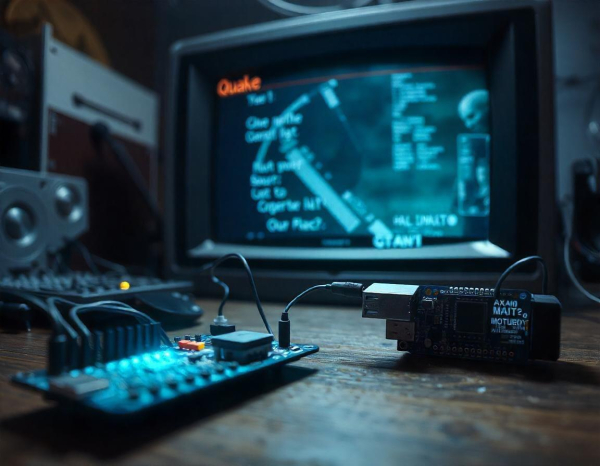Quake ported to Arduino Nano Matter. [Using only 276kb RAM]
Nicola Wrachien with Silicon Labs created this fun handheld, porting Quake using the Arduino Nano Matter. For easy playing a custom controller shaped board was designed with joysticks and a screen.
https://next-hack.com/index.php/2024/09/22/quake-port-to-sparkfun-and-arduino-nano-matter-boards-using-only-276-kb-ram/
#quake #arduino #nano #diy #handheld #port #retro #gaming #art #maker #engineer #artist #media #programming #tech #news
Nicola Wrachien with Silicon Labs created this fun handheld, porting Quake using the Arduino Nano Matter. For easy playing a custom controller shaped board was designed with joysticks and a screen.
https://next-hack.com/index.php/2024/09/22/quake-port-to-sparkfun-and-arduino-nano-matter-boards-using-only-276-kb-ram/
#quake #arduino #nano #diy #handheld #port #retro #gaming #art #maker #engineer #artist #media #programming #tech #news

![[ImageSource: Nicola Wrachien]
For a much tougher challenge, a group from Silicon Labs decided to port DOOM‘s successor, Quake, to the Arduino Nano Matter Board platform instead even though this platform has some pretty significant limitations for a game as advanced as Quake.
<https://community.silabs.com/s/share/a5UVm000000Vi1ZMAS/quake-ported-to-arduino-nano-matter-and-sparkfun-thing-plus-matter-boards?language=en_US>
To begin work on the memory problem, the group began with a port of Quake originally designed for Windows, allowing them to use a modern Windows machine to whittle down the memory usage before moving over to hardware. They do have a flash memory module available as well, but there’s a speed penalty with this type of memory. To improve speed they did what any true gamer would do with their system: overclock the processor. This got them to around 10 frames per second, which is playable, but not particularly enjoyable.
The further optimizations to improve the FPS required a much deeper dive which included generating lookup tables instead of relying on computation, optimizing some of the original C programming, coding some functions in assembly and only refreshing certain sections of the screen when needed. [ImageSource: Nicola Wrachien]
For a much tougher challenge, a group from Silicon Labs decided to port DOOM‘s successor, Quake, to the Arduino Nano Matter Board platform instead even though this platform has some pretty significant limitations for a game as advanced as Quake.
<https://community.silabs.com/s/share/a5UVm000000Vi1ZMAS/quake-ported-to-arduino-nano-matter-and-sparkfun-thing-plus-matter-boards?language=en_US>
To begin work on the memory problem, the group began with a port of Quake originally designed for Windows, allowing them to use a modern Windows machine to whittle down the memory usage before moving over to hardware. They do have a flash memory module available as well, but there’s a speed penalty with this type of memory. To improve speed they did what any true gamer would do with their system: overclock the processor. This got them to around 10 frames per second, which is playable, but not particularly enjoyable.
The further optimizations to improve the FPS required a much deeper dive which included generating lookup tables instead of relying on computation, optimizing some of the original C programming, coding some functions in assembly and only refreshing certain sections of the screen when needed.](https://friendica-leipzig.de/photo/preview/600/806495)
